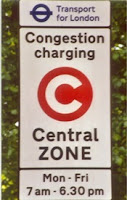Driving in Manhattan Won’t Be Free Much Longer
 In 2003, London instituted a £8, or about $16, “congestion charge” on any cars that entered central London. The aim was to clear some of the traffic and clutter from the center of the city, encourage public transportation use, and reduce air pollution. To many, including London’s mayor, Ken Livingstone, the plan was so successful that the city expanded the size of the zone in February to roughly double its size and encompass a larger portion of the city. Although at the time of the initial implementation, 40% of Londoners supported the surcharges, 60% of them did in 2006.
In 2003, London instituted a £8, or about $16, “congestion charge” on any cars that entered central London. The aim was to clear some of the traffic and clutter from the center of the city, encourage public transportation use, and reduce air pollution. To many, including London’s mayor, Ken Livingstone, the plan was so successful that the city expanded the size of the zone in February to roughly double its size and encompass a larger portion of the city. Although at the time of the initial implementation, 40% of Londoners supported the surcharges, 60% of them did in 2006.
Mr. Livingstone touts many successes of the charges:
- In 2002, the average vehicle traveling through the city moved at an average of 8.7 miles per hour; in 2003 it jumped to 10.5 miles per hour
- There are 16.4% fewer vehicles entering the city since 2002
- There is 16.4% less carbon dioxide emissions in the city than in 2002
- Traffic accidents with injuries fell from 2,296 in 2002 to 1,629 in 2005
The tolls work like this: When you drive through the marked toll zone between 7:00 a.m. and 6:00 p.m. (or 6:30 p.m., depending on the zone), hundreds of cameras photograph your car’s license plate. A computer matches your license plate number against a database of license plates that have paid the toll. Drivers have until midnight on the day they entered the toll zone to make payment (which can be done online, via text message, over the phone, or in convenience stores), or they face fines, which are sometimes very hefty. Residents who live within the toll zones receive a 90% discount. The system costs the city about $184 million per year to run, but generates $430 million in revenue (that’s a 57% profit margin).
They are not without opposition, even in London. Small business owners are concerned that the charges dissuade potential customers from shopping at their stores if they are within the toll zone. Privacy advocates hate the idea of the government tracking every car’s movements through the city.
Now, New York Mayor Michael Bloomberg would like to implement a similar plan in Manhattan, below 86th street. Under Mr. Bloomberg’s proposal, any car entering the area between 6:00 a.m. and 6:00 p.m. would be charged $8. Forget for a moment that the city is asking the federal government for between $200 million and $500 million for this initiative. Also forget for a moment that 55% of New Yorkers already use public transportation to commute to work. And finally, forget the fact that recording vehiclular movements Big Brother style goes counter to the loss of privacy that most Americans will tolerate. Those are all major issues with this initiative, to be sure. But what about the fact that Manhattan is an island? I mean, until amphibious cars are mainstreateam, the only way to get a car into Manhattan is via bridge, tunnel, or ferry, and nearly every way into Manhattan requires payment of a toll. So wouldn’t it be exponentially simpler to just add $8 onto tolls for vehicles entering Manhattan? The toll collection infrastructure – whether in the form of ferry tickets, E-ZPass, or human toll collectors – is already there.
The other thing that fundamentally bothers me about this idea as a car enthusiast is that, as if increasing traffic, increasing gas prices, and increasingly inconsiderate fellow drivers aren’t already conspiring to remove most of the fun from the driving experience, New York is basically trying to eliminate automobiles, at least to the largest extent they are able. That just doesn’t sit right with me.
I’ve only personally driven in Manhattan twice that I can recall; otherwise, every other time I have visited, I’ve either ridden the train or the ferry, so this concept doesn’t directly affect me. However, the idea is catching on in other cities, and it’s only a matter of time before a city near me – or you – tries to implement “congestion charges.” Say goodbye to automotive freedom and hello to bureaucracy.




